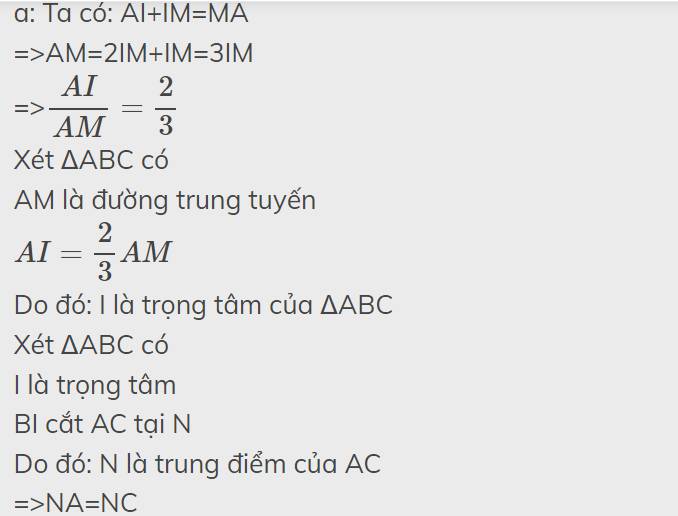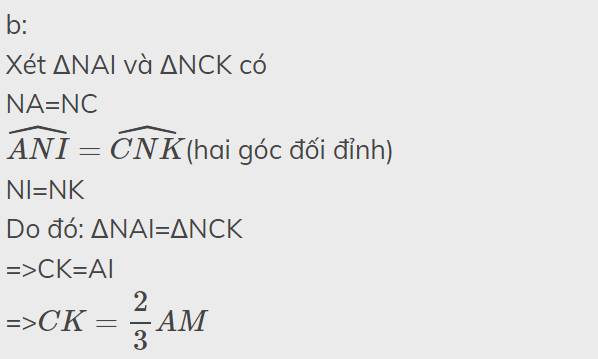Cho tam giác ABC có đường trung tuyến AM.TRên AM lấy điểm I sao cho AI=2IM.Tia BI cắt AC tại điểm N
a) Chứng minh AN=NC
b) Trên tia đối của tia NI lấy điểm K sao cho NK=NI. chứng minh CK= 2/3 AM
Hãy nhập câu hỏi của bạn vào đây, nếu là tài khoản VIP, bạn sẽ được ưu tiên trả lời.




a: AI+IM=AM
=>AM=2IM+IM=3IM
=>\(\dfrac{AI}{AM}=\dfrac{2}{3}\)
Xét ΔABC có
AM là đường trung tuyến
\(AI=\dfrac{2}{3}AM\)
Do đó: I là trọng tâm của ΔABC
Xét ΔABC có
I là trọng tâm
CI cắt AB tại P
Do đó: P là trung điểm của AB
=>PA=PB
b:
Xét ΔPIA và ΔPKB có
PI=PK
\(\widehat{IPA}=\widehat{KPB}\)(hai góc đối đỉnh)
PA=PB
Do đó: ΔPIA=ΔPKB
=>KB=AI
=>\(KB=\dfrac{2}{3}AM\)

Yêu cầu bạn @Nguyễn Phương Thảo B không sử dụng từ ngữ không văn minh lên diễn đàn!
Xin trân trọng!
a: Ta có: AI+IM=MA
=>AM=2IM+IM=3IM
=>\(\dfrac{AI}{AM}=\dfrac{2}{3}\)
Xét ΔABC có
AM là đường trung tuyến
\(AI=\dfrac{2}{3}AM\)
Do đó: I là trọng tâm của ΔABC
Xét ΔABC có
I là trọng tâm
BI cắt AC tại N
Do đó: N là trung điểm của AC
=>NA=NC
b:
Xét ΔNAI và ΔNCK có
NA=NC
\(\widehat{ANI}=\widehat{CNK}\)(hai góc đối đỉnh)
NI=NK
Do đó: ΔNAI=ΔNCK
=>CK=AI
=>\(CK=\dfrac{2}{3}AM\)

a) M(x) = P(x) + Q(x)
= (x² + 5x - 3) + (2x² - 3x + 1)
= x² + 5x - 3 + 2x² - 3x + 1
= (x² + 2x²) + (5x - 3x) + (-3 + 1)
= 3x² + 2x - 2
b) M(x) - N(x) = 3x² + 2
N(x) = M(x) - (3x² + 2)
= (3x² + 2x - 2) - (3x² + 2)
= 3x² + 2x - 2 - 3x² + 2
= (3x² - 3x²) + 2x + (-2 - 2)
= 2x - 4
Cho N(x) = 0
2x - 4 = 0
2x = 4
x = 4 : 2
x = 2
Vậy nghiệm của đa thức N(x) là x = 2
Yêu cầu bạn @Nguyễn Phương Thảo không sử dụng từ ngữ không văn minh!
Xin chân trọng!

\(9x^3-18x=0\)
\(9x\left(x-2\right)=0\)
\(9x=0\) hoặc \(x-2=0\)
*) \(9x=0\)
\(x=0\)
*) \(x-2=0\)
\(x=2\)
Vậy đa thức đã cho có nghiệm \(x=0;x=2\)
9\(x^3\) - 18\(x\) = 0
9.\(x\)(\(x^2\) - 2) = 0
\(\left[{}\begin{matrix}x=0\\x^2-2=0\end{matrix}\right.\)
\(\left[{}\begin{matrix}x=0\\x=-\sqrt{2}\\x=\sqrt{2}\end{matrix}\right.\)
Vậy \(x\) \(\in\) {- \(\sqrt{2}\); 0; \(\sqrt{2}\)}


\(C=-3\left(x-3\right)^2-\left(y-1\right)^2-2021\)
Ta có:
\(\left(x-3\right)^2\ge0\Rightarrow-3\left(x-3\right)^2\le0\)
\(\left(y-1\right)^2\ge0\Rightarrow-\left(y-1\right)^2\le0\)
\(\Rightarrow-3\left(x-3\right)^2-\left(y-1\right)^2-2021\le-2021\)
Vậy giá trị lớn nhất của C là \(-2021\) khi \(x=3;y=1\)

a: f(x) chia hết cho g(x)
=>\(2x^2-x+2⋮x+1\)
=>\(2x^2+2x-3x-3+5⋮x+1\)
=>\(5⋮x+1\)
=>\(x+1\in\left\{1;-1;5;-5\right\}\)
=>\(x\in\left\{0;-2;4;-6\right\}\)
b: Để f(x) chia hết cho g(x) thì \(3x^2-4x+6⋮3x-1\)
=>\(3x^2-x-3x+1+5⋮3x-1\)
=>\(5⋮3x-1\)
=>\(3x-1\in\left\{1;-1;5;-5\right\}\)
=>\(3x\in\left\{2;0;6;-4\right\}\)
=>\(x\in\left\{\dfrac{2}{3};0;2;-\dfrac{4}{3}\right\}\)
mà x là số nguyên
nên \(x\in\left\{0;2\right\}\)
a) f(x) = 2x² - x + 2
= 2x² + 2x - 3x - 3 + 5
= 2x(x + 1) - 3(x + 1) + 5
Để f(x) chia hết cho g(x) thì 5 ⋮ (x + 1)
⇒ x + 1 ∈ Ư(5) = {-5; -1; 1; 5}
⇒ x ∈ {-6; -2; 0; 4}

Ta có:\(x=100\)
\(\Rightarrow x+1=101\)
\(\Rightarrow M=x^8-\left(x+1\right)x^7+\left(x+1\right)x^6-\left(x+1\right)x^5+...+\left(x+1\right)x^2-\left(x+1\right)x+125\\ \Rightarrow M=x^8-x^8-x^7+x^7+x^6-x^6-x^5+...x^3+x^2-x^2-x+125\\ \Rightarrow M=-x+125\\ \Rightarrow M=-100+125\\ \Rightarrow M=25.\)